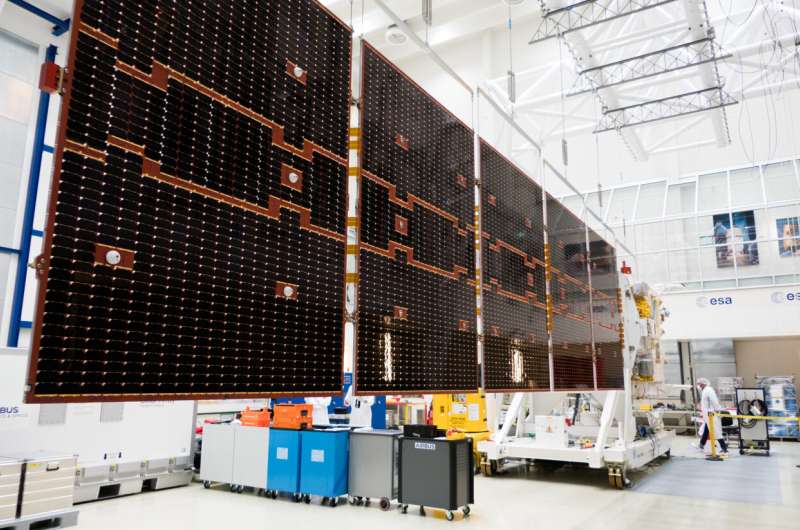
ESA’s upcoming EarthCARE satellite mission has just taken a big stretch. Engineers have gently unfolded this new satellite’s huge five-panel solar wing to test that it will deploy correctly once it is in space. The solar wing is a critical part of the satellite, providing the energy for EarthCARE to do its job: to quantify the role that clouds and aerosols play in heating and cooling Earth’s atmosphere.
EarthCARE is one of ESA’s Earth Explorer missions. Since the launch of the first Earth Explorer in 2009, this family of world-class research missions has continued to demonstrate how breakthrough satellite technology and novel observing techniques can deliver an astounding range of scientific findings about our planet.
Our world, and the life it sustains, is under increasing pressure, particularly as a consequence of climate change. The need to better understand how our planet functions as a system is more urgent than ever before.
This need isn’t solely for academic interest, but to ensure that we are equipped with key information for decision-making to benefit of society.
EarthCARE will soon be launched to answer some critical scientific questions related to the role that clouds and aerosols play in both reflecting incident solar radiation back out to space and trapping infrared radiation emitted from Earth’s surface. This delicate balance is an important factor in regulating Earth’s temperature.
Although clouds play an extremely important role in atmospheric heating and cooling, they remain one of the biggest mysteries—in fact the least understood factor in our understanding of how the atmosphere drives the climate system.
It is, therefore, vital for climate research and weather prediction that we improve our understanding of the internal structure and spatial distribution of clouds, their relationship to aerosols and radiation and how a warming climate changes clouds, which, in turn alters their warming and cooling effects.
For EarthCARE to deliver the measurements that are needed to make this important step forward in atmospheric science, it carries a suite of instruments, namely an atmospheric lidar, a Doppler cloud radar, a multispectral imager and a broad-band radiometer. The lidar, radar and imager together will provide unprecedented measurements of clouds and aerosols and the radiometer will measure the radiation.
While its suite of instruments is impressive, so is its single 11 m-long solar wing, which in orbit will be outstretched at the rear of the satellite.
As engineers are preparing EarthCARE for its life in orbit, the satellite is spending the next seven months at ESA’s ESTEC Test Center in the Netherlands—the largest satellite test facility in Europe. This 3,000 sq m environmentally-controlled complex hosts test equipment to simulate every aspect of the space environment, from the vacuum and temperature extremes of Earth orbit to the violent noise and vibration of a rocket launch.
One of the first tests involved the deployment of the solar wing from its folded stowed configuration, which allows it to fit inside the rocket fairing, to its fully deployed configuration as it will be in orbit around Earth.
ESA’s Mehrdad Rezazad said, “We have a long list of tests that we have to put EarthCARE though in preparation for launch and flight. The team from Airbus, who is the prime contractor for EarthCARE, and the ESA and JAXA consortium teams have been working very hard to keep to schedule.
“We are extremely happy to say that the solar wing deployment test went very well. The timely and complete deployment of the large solar wing soon after launch is crucial to the mission.
“Since we have to deal with gravity on the ground, the separate panels were supported by wires for the test. In orbit the ties, holding the five panels together during the launch configuration, will be automatically sliced open by set of thermal knives, releasing the folded wing so that it can deploy fully behind the satellite platform.”
With the first solar array deployment test now ticked off the “to do” list, the various vibration and thermal-vacuum tests are to follow. These tests will simulate the environment of liftoff and space.
EarthCARE satellite’s solar wing expanded for testing (2022, July 22)
retrieved 23 July 2022
from https://phys.org/news/2022-07-earthcare-satellite-solar-wing.html
part may be reproduced without the written permission. The content is provided for information purposes only.